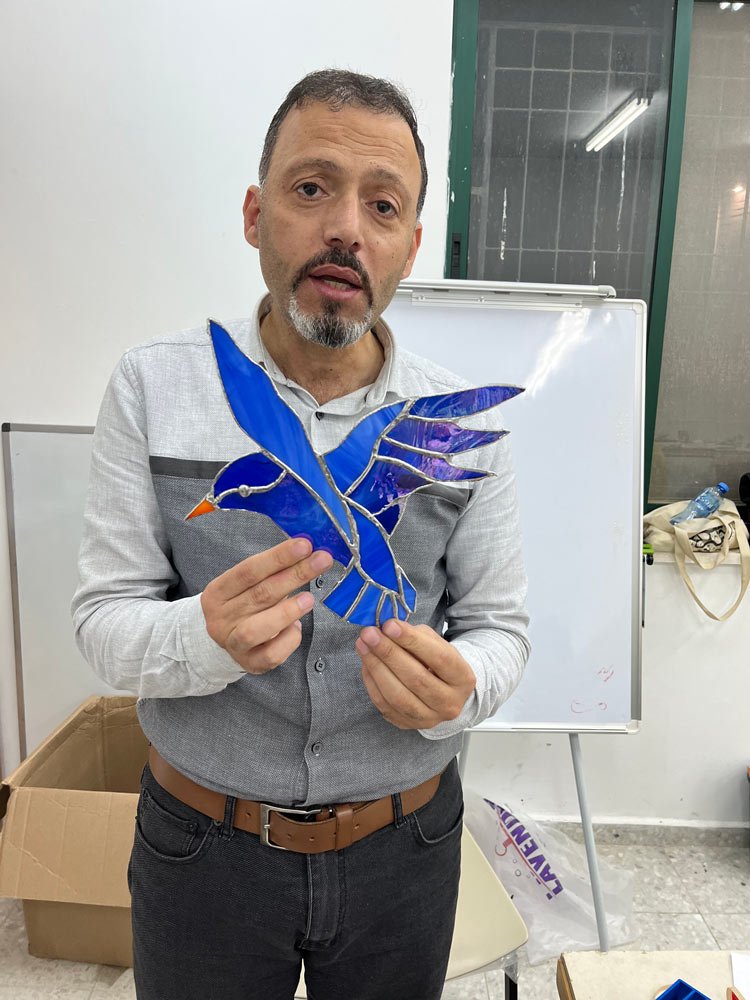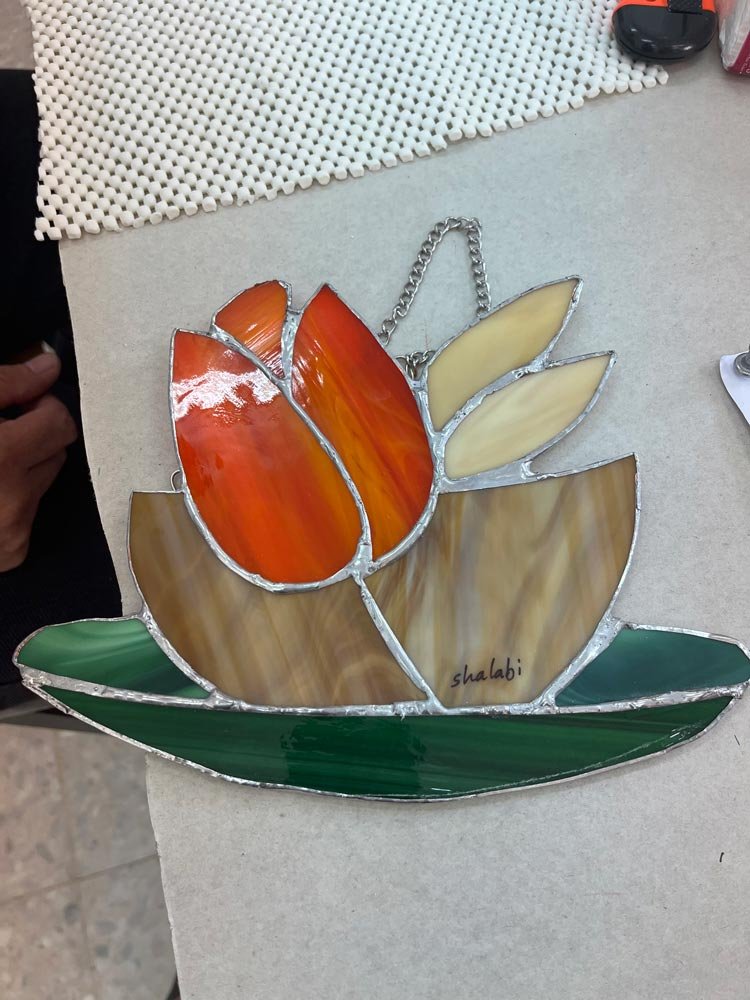by Kosovare Grebe
At the Muna and Basem Hishmeh Foundation, we spend most of our time making and holding space for so many others, that when one of our own gets a moment to shine, it’s very special. Not too long ago, between May and October of 2022, our co-founder, Muna Hishmeh, was asked to lead a workshop teaching stained glass after visiting the Visual Art Forum on one of her trips to Palestine. For those that don’t know, Muna is an experienced stained glass artist and has been commissioned by friends and family for years to create various pieces that adorn all of our homes and even some community centers around the world. To have a piece by Muna is to have a special treasure made with love, so it was no surprise that she was asked about this endeavor.
I got to take off my granddaughter hat and put on my journalist hat for this one, as I was able to interview my grandmother on her experience teaching these classes and where her passion for stained glass came from.
Kosovare: Was this part of a series of workshops with different leaders or was it just you teaching the workshop?
Muna: No, it was just me. When I was visiting the Visual Art Forum, the Art Forum has art classes for children after school and on weekends. All different kinds of arts and all mediums. So when I was there in May, they found out I do stained glass and asked me if I would do a workshop to teach stained glass in October when I returned and I said yes. Then we checked out to see what the availability of supplies and tools and such was, it didn't seem like too much of it existed [in the area] so I said I will put some things together and ship them. The only thing I was not able to ship was glass and flux. I was told that there was a supply of glass in Jerusalem from a Palestinian artist who paints on glass, but I needed the glass that’s already colored and he had that.
So my box arrived and we arrived in October. They sent out notices that I was going to have this workshop and 10 adults signed up. 8 women and 2 men. I was able to go to Jerusalem and get the glass and the flux and proceeded to do the workshop. They had the space set up for me. Unfortunately not all 10 people could come at the same time because some were coming from Jerusalem and they had issues in coming over. So one day they could come and the next they couldn’t. The workshop lasted almost 2 weeks and I gave them a project to do that wasn’t very difficult for starters and some did 2 projects. They all wanted to continue but unfortunately we ran out of flux and we were not able to get it locally. They were all very excited about doing the workshop, not realizing they could actually cut glass and put it back together again. One of the people that took the course is a professor at a local college, some of the students there are special needs. They teach them a skill or a craft for them to continue after they finish their schooling. This professor specializes in Arabic calligraphy, so at the end of the sessions as I was saying goodbye to everyone, he, they all, gave me this piece of calligraphy that he wrote. It’s a quote from the famous Palestinian poet Mahmoud Darwish “The butterfly does not leave its imprint but the butterfly will leave its impression.” And that’s it, they said they were going to continue possibly doing more stained glass if they were able to get the flux.
The butterfly does not leave its imprint but the butterfly will leave its impression.
K: Did you have any opportunities like this growing up? Any art workshops, anything like that?
M: No. My father was a factory worker, my mother was a seamstress, there was no extra money for the arts so to speak other than what I learned in school.
K: When did you discover stained glass as an art medium?
M: When we first moved to New Jersey, I had met a stained glass artist in Atlanta and commissioned him to do 2 windows for me for our house. I told him what design I wanted and I approved the design when he finished making it, and I told him what colors I wanted and he proceeded to make the 2 panels. When they were done he shipped them to me, unfortunately when I opened the crate, everything was broken into tiny little pieces. He was a stained glass artist but he didn’t know how to pack! So I put it on hold, kept the pattern, and then lo and behold I found 2 ladies in a local town near my town that would give stained glass classes. So I took it and loved it. My father built me a workshop in the basement and thats when it all started and I continued to do it. Once you take the lessons and you learn the procedure, it’s not necessary to continue taking lessons. So I kept doing it, I eventually made the 2 panels myself and now I do it for fun I do it for friends and family members.
K: What do you think connected you to it?
M: I liked the way it looked. I didn’t care too much for the heavy duty leaded glass other than it was very pretty, but when I found out about this one it’s called the Tiffany method, and I just liked the way it looked. I used to do quilting and basically I compare them to be the same. When you want to do a quilt, you make a design, you pick out the fabric you wanna use, then you cut up the fabric into pieces then you sew them back together again. Well the stained glass is similar, you make out your design/pattern, you pick out the glass you want to use, you cut up the glass into small pieces then you weld it back together. I enjoy it a lot more than the quilting!
K: What was it like to be asked to teach the workshop?
M: It was very nice, very exciting. I was happy, I’m always happy to teach whatever I know to anybody so I was happy to do it.
K: Do you consider yourself part of each piece you create? Like there is a piece of you in all of your artwork?
M: Well, only maybe in the colors I choose, and I like the abstract designs. I guess my surroundings are very abstract.
K: Do you think it’s important for the artist to take themselves out of the equation and to let the art speak for itself?
M: Speaking for me, since I never had art lessons, I’m not very good at drawing things. So if I’m going to have a tree in my design, I Google a tree, and Google sends me a print and I can draw it from the print. But for me to freehand draw it, I cannot. So for me, the abstract comes a little easier because I can do curves and waves and then put colors together. So is it me in the design? I guess to some people it might be. I guess it could be. But thats not the intent I don’t think. It’s whatever moves me that day.
K: What was your most memorable moment from your experience leading the workshop?
M: The camaraderie of the people I met for the first time and hearing a little bit of their stories and them asking me questions and that they were really interested in learning and very excited in learning it.
K: Do you think the whole point of art is to bring people together?
M: I think thats one aspect of it. Art is really for people to know whats going on in the world, what drives people, what makes them do what they do in the form of art they use. So it does bring people together but it’s not the sole meaning of it I guess.
K: You make so much art for family and friends, do you have a favorite piece that you’ve made? Or one that spoke to you more than others?
M: I like the one with the Oud, the one that I gifted to the Edward Said Conservatory. And that one, one of my friends helped me draw that one, Gail. The last piece I finish is usually my favorite so I guess it’s hard to say which one for sure.
K: Are you aware that your existence has brought so many people a joy that cannot be replaced?
M: No! Well I hope I bring joy to people! I love people! Most of all my favorite are my 6 grandchildren.
K: Was there a “you” in your life that you model your own life after?
M: I don’t think one particular person. Mother, grandmother, mother in law, great grandmother.
Journalist hat off for a moment, it makes my heart proud to know that a woman so instrumental in my own upbringing was made by all the women in her life before her. It really shows how when we build each other up, we have the power to create wonderful people who really give something to this world. Women have always been at the centers of community building and sharing knowledge for generations, and knowing that the woman I look up to in every way stays close to that mold shows me how much knowledge has been passed down to me without my even knowing. There’s a real sense of connection to the women that came before me that I realized in that instance interviewing my grandmother. To know that she is a product of all the women in her life, and that I am a product of all the women in my life, we are all connected throughout generations without even ever having met. What a beautiful power we get to hold.
Okay, journalist hat back on! As mentioned in the interview, one student, Mohammad Shalabi, gave a piece of his own artwork in the form of Arabic Calligraphy as a thank you to Muna for teaching the workshop.
Muna Hishmeh, The Artist
Because you plant roses … and wipe away tears … and draw a smile,
Then you are an angel in the form of a human being
The few days and moments that brought us together
are some of our most beautiful days.
May you stay loyal to your family
And true to your national roots
May you always be able to give
And may you always have good health and happiness
And your beautiful smile
Your admirers
Visual Arts Forum Family
Stained Glass Workshop
Ramallah, Palestine
25 October 2022
A huge takeaway from this interview was just how important new experiences are, no matter where you are in life. You could think you’ve aged out of trying something new but you could be limiting yourself of a talent you were always meant to give to the world. You could be forced to stay in your hometown by outside forces, but if you give up, you could be missing out on learning a skill that could change your life. Basically, each person involved in this workshop had no idea what they were getting themselves into when they started their stained glass journey. Muna thought she was just getting 2 new windows. Instead she opened a door full of possibilities.










